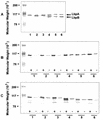Cloning and expression of the Moraxella catarrhalis lactoferrin receptor genes
- PMID: 9673246
- PMCID: PMC108399
- DOI: 10.1128/IAI.66.8.3656-3665.1998
Cloning and expression of the Moraxella catarrhalis lactoferrin receptor genes
Abstract
The lactoferrin receptor genes from two strains of Moraxella catarrhalis have been cloned and sequenced. The lfr genes are arranged as lbpB followed by lbpA, a gene arrangement found in lactoferrin and transferrin receptor operons from several bacterial species. In addition, a third open reading frame, orf3, is located one nucleotide downstream of lbpA. The deduced lactoferrin binding protein A (LbpA) sequences from the two strains were found to be 99% identical, the LbpB sequences were 92% identical, and the ORF3 proteins were 98% identical. The lbpB gene was PCR amplified and sequenced from a third strain of M. catarrhalis, and the encoded protein was found to be 77% identical and 84% similar to the other LbpB proteins. Recombinant LbpA and LbpB proteins were expressed from Escherichia coli, and antisera raised to the purified proteins were used to assess antigenic conservation in a panel of M. catarrhalis strains. The recombinant proteins were tested for the ability to bind human lactoferrin following gel electrophoresis and electroblotting, and rLbpB, but not rLbpA, was found to bind lactoferrin. Bactericidal antibody activity was measured, and while the anti-rLbpA antiserum was not bactericidal, the anti-rLbpB antisera were found to be weakly bactericidal. Thus, LbpB may have potential as a vaccine candidate.
Figures








Similar articles
-
Characterization of Moraxella (Branhamella) catarrhalis lbpB, lbpA, and lactoferrin receptor orf3 isogenic mutants.Infect Immun. 1999 Mar;67(3):1517-20. doi: 10.1128/IAI.67.3.1517-1520.1999. Infect Immun. 1999. PMID: 10024604 Free PMC article.
-
The transferrin binding protein B of Moraxella catarrhalis elicits bactericidal antibodies and is a potential vaccine antigen.Infect Immun. 1998 Sep;66(9):4183-92. doi: 10.1128/IAI.66.9.4183-4192.1998. Infect Immun. 1998. PMID: 9712766 Free PMC article.
-
Preparation and characterization of Neisseria meningitidis mutants deficient in production of the human lactoferrin-binding proteins LbpA and LbpB.J Bacteriol. 1998 Jun;180(12):3080-90. doi: 10.1128/JB.180.12.3080-3090.1998. J Bacteriol. 1998. PMID: 9620956 Free PMC article.
-
Bacterial lactoferrin receptors.Adv Exp Med Biol. 1998;443:123-33. doi: 10.1007/978-1-4757-9068-9_15. Adv Exp Med Biol. 1998. PMID: 9781351 Review.
-
Vaccines for Moraxella catarrhalis.Vaccine. 2000 Dec 8;19 Suppl 1:S101-7. doi: 10.1016/s0264-410x(00)00287-5. Vaccine. 2000. PMID: 11163472 Review.
Cited by
-
Lactoferrins in Their Interactions with Molecular Targets: A Structure-Based Overview.Pharmaceuticals (Basel). 2024 Mar 20;17(3):398. doi: 10.3390/ph17030398. Pharmaceuticals (Basel). 2024. PMID: 38543184 Free PMC article. Review.
-
Bacterial infection in chronic obstructive pulmonary disease in 2000: a state-of-the-art review.Clin Microbiol Rev. 2001 Apr;14(2):336-63. doi: 10.1128/CMR.14.2.336-363.2001. Clin Microbiol Rev. 2001. PMID: 11292642 Free PMC article. Review.
-
Characterization of binding of human lactoferrin to pneumococcal surface protein A.Infect Immun. 2001 May;69(5):3372-81. doi: 10.1128/IAI.69.5.3372-3381.2001. Infect Immun. 2001. PMID: 11292760 Free PMC article.
-
Vaccine targets against Moraxella catarrhalis.Expert Opin Ther Targets. 2016;20(1):19-33. doi: 10.1517/14728222.2015.1081686. Epub 2015 Aug 26. Expert Opin Ther Targets. 2016. PMID: 26565427 Free PMC article. Review.
-
Characterization of Moraxella (Branhamella) catarrhalis lbpB, lbpA, and lactoferrin receptor orf3 isogenic mutants.Infect Immun. 1999 Mar;67(3):1517-20. doi: 10.1128/IAI.67.3.1517-1520.1999. Infect Immun. 1999. PMID: 10024604 Free PMC article.
References
-
- Bluestone C D. Modern management of otitis media. Pediatr Clin North Am. 1989;36:1371–1377. - PubMed
-
- Bonnah R A, Yu R H, Schryvers A B. Biochemical analysis of lactoferrin receptors in the Neisseriaceae: identification of a second bacterial lactoferrin receptor protein. Microb Pathog. 1995;19:285–297. - PubMed
-
- Bonnah R A, Yu R-H, Wong H, Schryvers A B. Biochemical and immunological properties of lactoferrin binding proteins from Moraxella (Branhamella) catarrhalis. Microb Pathog. 1998;24:89–100. - PubMed
MeSH terms
Substances
Associated data
- Actions
- Actions
- Actions
LinkOut - more resources
Full Text Sources
Other Literature Sources

